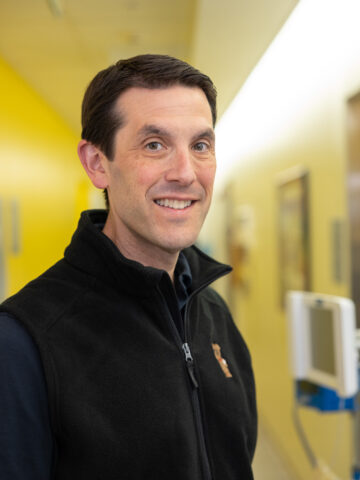Pediatric sports medicine, innovative knee trochleoplasty surgeries at CHOC
Southern California is a hotbed for youth sports and, as a result, pediatric sports injuries. High patient volume is helping drive pediatric sports medicine innovation at CHOC, where young athletes benefit from leading-edge surgical approaches to treat patellofemoral instability and patellar dislocation, as well as a strategy to mitigate postsurgical pain without narcotics.
Effective treatment early on enables young athletes to return to play with less risk of repeat injury, as well as lower chances of chronic instability or arthritis in the joint later in life.
Trochleoplasty surgery to reduce recurrent patellofemoral instability
For nearly eight years, Dr. John Schlechter, board-certified pediatric orthopaedic surgeon at CHOC, has performed trochleoplasty in adolescents with severe developmental dysplasia of the trochlear groove. Data he’s collected for an upcoming scholarly submission reveal the procedure’s potential to improve knee stability, which is key to patients’ ability to participate and excel in sports.

“Some patients present with a subluxated or fixed dislocated patella,” Dr. Schlechter says. “Trochleoplasty is an advanced procedure that’s not done at every center in the U.S. It’s technically demanding and reserved for the most severe cases of patellofemoral instability. Our outcomes have been favorable.”
The technical challenge, according to Dr. Schlechter, comes from avoiding damage to the cartilage when elevating and separating it from the subchondral bone and, later, positioning it in the new trochlear groove.
Out of 21 patients followed for an average of 3.3 years after trochleoplasty, only four required subsequent procedures — three for motion-restoring manipulation due to postoperative stiffness and one to close a surgical wound that reopened. None of the patients returned to the operating room for recurrent instability or arthritis.
“Trochleoplasty produces better outcomes [than previous forms of treatment, such as reconstruction of the medial patellofemoral ligament] in the sense of less recurrent instability, more stability and more confidence in what the patient can do postoperatively,” Dr. Schlechter says. “When it works, trochleoplasty is a powerful procedure as far as containing the patella from recurrent instability in the future.”
Bracing against further instability following patellar dislocation
Compliance with the standard of care (physical therapy and external knee bracing) can be challenging for children and adolescents who experience a first-time patellar dislocation, leading to a high rate of recurrence, according to Dr. Schlechter.
“Other surgeons have tended to repair the medial patellofemoral ligament,” he says. “Those surgeries have had mixed outcomes, with failure rates up to around 30% where patients would dislocate after a medial reefing.”
A middle ground between knee ligament reconstruction and repair
Wondering if he could find a middle-of-the-road option between ligament reconstruction and repair, Dr. Schlechter turned to InternalBrace, a suture tape implant used for ankle ligament augmentation.
“I was thinking to myself, can I use InternalBrace for the medial patellofemoral ligament?” Dr. Schlechter says. “Can I put the implant between the patella and femur to act as a checkrein to the lateral glide of the patella in patients who sustain a first-time patellar dislocation with a concomitant fracture of their cartilage and bone, a loose piece in the knee … that’s fractured at the time of the first patellar dislocation? And, by the way, while I’m in there, can I do something to tighten up the knee to prevent further dislocations by applying this tape?”
Dr. Schlechter began using InternalBrace for primary patellar dislocations in 2014. Recently, he compared a subset of patients who had a first-time patellar dislocation with an osteochondral fracture of the knee and InternalBrace with pre-2014 patients who had a primary patellar dislocation and fixation of an osteochondral fracture without InternalBrace. More than one-fourth of patients who did not have the implant required additional surgical stabilization. None of the patients with InternalBrace, however, needed further stabilization.
Moving past narcotics for postoperative pain mitigation for trochleoplasty knee surgery recoveries
In an effort to limit postsurgical pain for knee surgery patients, Dr. Schlechter investigated the use of an indwelling catheter pump as a longer-lasting alternative to a single-shot regional nerve block.
“We designed a study looking at patients who had the indwelling catheter pump that was placed at an inpatient surgery center compared with patients who had their procedures at an outpatient surgery center where the pump wasn’t available,” Dr. Schlechter says. “What we found, surprisingly, is that 70% of patients [across both study groups] did not use home narcotics after anterior cruciate ligament reconstruction.”
Motivated to limit narcotics prescribing and having concluded the indwelling catheter pump would not be useful, Dr. Schlechter set about finding a solution for the 30% of patients who did take narcotics following ACL reconstruction.
“I started using a long-acting medicine vs. a short-acting medicine as a single-shot nerve block,” Dr. Schlechter says. “I found that, among patients who get the long-acting medicine, around 92% to 93% won’t use narcotics, compared with 70% who get the short-acting medicine. Now, we’re designing a prospective, randomized study to look at this, but in the retrospective study we published, we found we can get the number up to the low [90th percentile] with the long-acting medicine, with an excellent patient profile.”
As a result, Dr. Schlechter’s knee surgery patients no longer go home with narcotics to mitigate pain, and parents have embraced the change.
Learn more about CHOC’s sports medicine program




